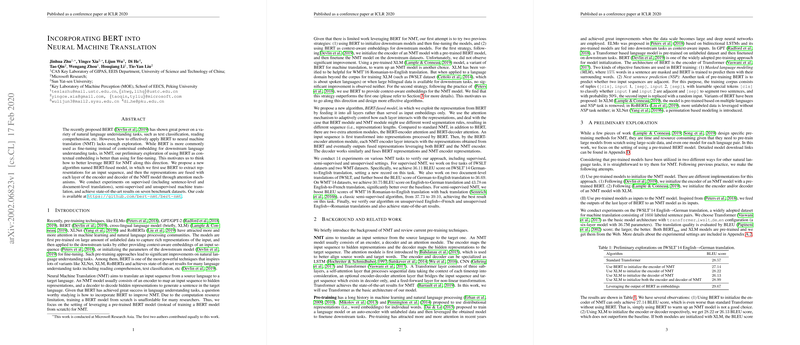Incorporating BERT into Neural Machine Translation
The paper investigates the integration of BERT, a prominent pre-trained LLM, into Neural Machine Translation (NMT). The authors propose a BERT-fused model that utilizes BERT's ability to provide context-aware representations, aiming to enhance NMT performance across various settings, including supervised, semi-supervised, and unsupervised translation tasks.
Research Motivation
BERT has significantly improved results in natural language understanding tasks; however, its application in NMT remains underexplored. Traditional strategies like using BERT for initializing NMT models or as input embeddings have shown limited success. This paper explores an alternative approach by fusing BERT representations with the encoder and decoder layers of the NMT model through attention mechanisms.
Methodology
The proposed BERT-fused model extracts representations from BERT and incorporates them into all layers of the NMT encoder and decoder. Attention mechanisms are employed to effectively blend BERT's features with NMT's inherent sequential processing capabilities. This design addresses issues such as differing tokenization schemes between BERT and NMT modules. Additionally, the paper introduces a novel drop-net trick to regularize training by probabilistically using BERT-encoder or self-attention outputs, thereby reducing overfitting.
Experimental Evaluation
The authors conduct extensive experiments across different translation tasks to validate their approach:
- Supervised NMT: Experiments cover low-resource (IWSLT datasets) and high-resource (WMT datasets) scenarios. The BERT-fused model achieved a BLEU score of 36.11 on the IWSLT'14 De-to-En task, surpassing previous methods.
- Document-Level NMT: Utilizing BERT's sentence relations, the model improves translation by incorporating document-level context.
- Semi-Supervised NMT: The approach demonstrates significant improvements when combined with back-translation methods, achieving state-of-the-art results on the WMT'16 Romanian-to-English task.
- Unsupervised NMT: The model outperforms previous unsupervised methods on En↔Fr and En↔Ro tasks by effectively leveraging XLM, a variant of BERT.
Results and Implications
The BERT-fused model consistently outperformed baselines across all tested datasets, setting new benchmarks for various translation tasks. This work illustrates the practical benefits of combining pre-trained LLMs with NMT, reaffirming BERT's utility beyond mere language understanding. The paper maintains a comprehensive code repository, facilitating reproducibility and further research.
Future Directions
The authors acknowledge potential improvements in reducing the additional storage and inference time costs introduced by BERT integration. Future work could focus on optimizing such trade-offs and exploring BERT incorporation in other AI domains, such as question answering. Additionally, investigating model compression techniques could lead to more efficient deployment of BERT-enhanced NMT systems.
This research contributes substantially to the field of NMT by effectively exploiting pre-trained LLMs, particularly highlighting BERT's potential in enhancing translation quality through innovative architectural integration.
